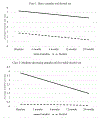Trajectories of alcohol and cannabis use among emerging adults with a history of unstable housing: Associations with functioning over a two-year period
- PMID: 38340400
- PMCID: PMC12148046
- DOI: 10.1016/j.drugalcdep.2024.111117
Trajectories of alcohol and cannabis use among emerging adults with a history of unstable housing: Associations with functioning over a two-year period
Abstract
Introduction: Research has documented high rates of alcohol and cannabis use among emerging adults experiencing homelessness. However, little is known about trajectories of use over time or how trajectories are associated with functioning (e.g., risk behaviors, mental and physical health, social functioning, economic well-being).
Methods: Data come from a cohort of 18-25 year olds experiencing homelessness who were surveyed 5 times over 24 months. Parallel process growth mixture models were used to model heterogeneity in alcohol and cannabis use across the 5 timepoints, which allowed for the extraction of classes based on both alcohol and cannabis use trajectories. Classes were compared on demographics and functioning at baseline and 24-months.
Results: Two trajectory classes of alcohol and cannabis use emerged: moderate decreasing cannabis and low stable alcohol use (75% of the sample) and heavy cannabis and alcohol use (25% of the sample). The heavy cannabis and alcohol use class reported a significantly higher likelihood for any non-cannabis drug use at baseline and 24-months, as well as greater depression and physical ailments at 24-months. In addition, at 24-months this class had a marginally higher likelihood of a positive screen for at least moderate anxiety and being recently unhoused.
Conclusions: The effects of heavy continued cannabis and alcohol co-use on multiple domains of functioning (e.g., risk behavior, mental and physical health) highlight the importance of a coordinated systems approach that addresses the often complex and interrelated challenges facing emerging adults with a history of homelessness.
Keywords: Functional outcomes; Homeless; Substance use; Trajectories; Young adult.
Copyright © 2024. Published by Elsevier B.V.
Conflict of interest statement
Declaration of Competing Interest No conflicts declared.
Figures
Similar articles
-
Parallel trajectories of vaping and smoking cannabis and their associations with mental and physical well-being among young adults.Drug Alcohol Depend. 2023 Oct 1;251:110918. doi: 10.1016/j.drugalcdep.2023.110918. Epub 2023 Aug 9. Drug Alcohol Depend. 2023. PMID: 37611482 Free PMC article.
-
Patterns of Substance Use and Associations with Mental, Physical, and Social Functioning: A Latent Class Analysis of a National Sample of U.S. Adults Ages 30-80.Subst Use Misuse. 2021;56(1):131-139. doi: 10.1080/10826084.2020.1843059. Epub 2020 Nov 9. Subst Use Misuse. 2021. PMID: 33167746 Free PMC article.
-
Trajectories and mental health-related predictors of perceived discrimination and stigma among homeless adults with mental illness.PLoS One. 2020 Feb 27;15(2):e0229385. doi: 10.1371/journal.pone.0229385. eCollection 2020. PLoS One. 2020. PMID: 32106225 Free PMC article. Clinical Trial.
-
A comprehensive review of prioritised interventions to improve the health and wellbeing of persons with lived experience of homelessness.Campbell Syst Rev. 2021 Jun 24;17(2):e1154. doi: 10.1002/cl2.1154. eCollection 2021 Jun. Campbell Syst Rev. 2021. Update in: Campbell Syst Rev. 2019 Sep 12;15(3):e1048. doi: 10.1002/cl2.1048. PMID: 37131928 Free PMC article. Updated. Review.
-
Folic acid supplementation and malaria susceptibility and severity among people taking antifolate antimalarial drugs in endemic areas.Cochrane Database Syst Rev. 2022 Feb 1;2(2022):CD014217. doi: 10.1002/14651858.CD014217. Cochrane Database Syst Rev. 2022. PMID: 36321557 Free PMC article.
Cited by
-
Mental Health and Substance Use Among Black Women Attending STD Clinics in Baltimore: The Role of Overt and Subtle Discrimination.J Urban Health. 2025 Apr;102(2):432-444. doi: 10.1007/s11524-024-00930-3. Epub 2024 Nov 5. J Urban Health. 2025. PMID: 39499418
References
-
- Arnett JJ, 2005. The developmental context of substance use in emerging adulthood. J Drug Issues. 35, 235–253
-
- Asparouhov T, Muthén B, 2014. Auxiliary variables in mixture modeling: Three-step approaches using M plus. Struc Equ Modeling. 21, 329–341.
-
- Chassman S, Barman-Adhikari A, Hsu H-T, Ferguson KM, Narendorf SC, Santa Maria D, et al., 2022. Prevalence and correlates of illicit substance use among young adults experiencing homelessness in seven cities across the United States. J Drug Issues. 52, 488–508.
-
- Cohn AM, Johnson AL, Rose SW, Pearson JL, Villanti AC, Stanton C, 2018. Population-level patterns and mental health and substance use correlates of alcohol, marijuana, and tobacco use and co-use in US young adults and adults: Results from the Population Assessment for Tobacco and Health. Am J Addictions. 27, 491–500. - PMC - PubMed
MeSH terms
Grants and funding
LinkOut - more resources
Full Text Sources
Medical


